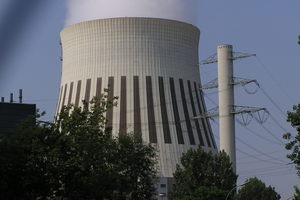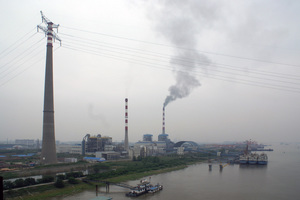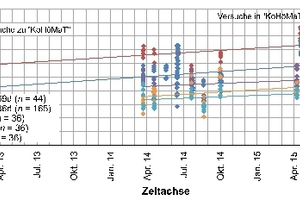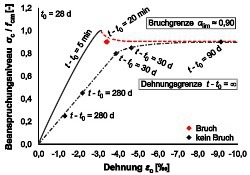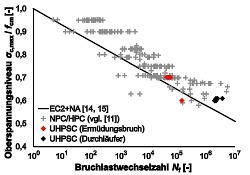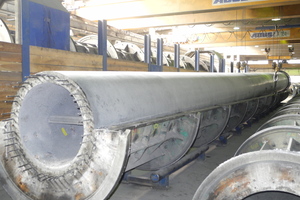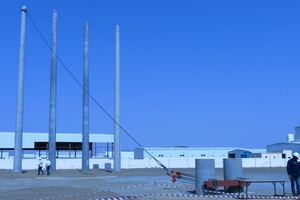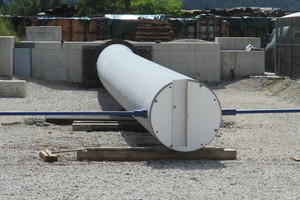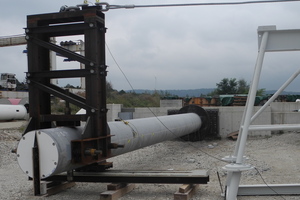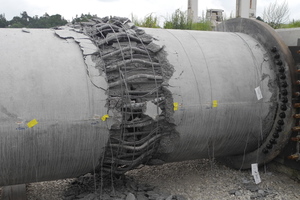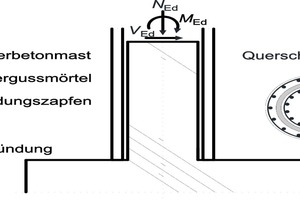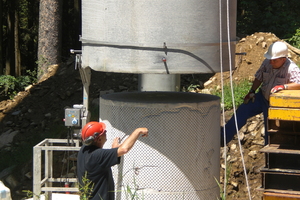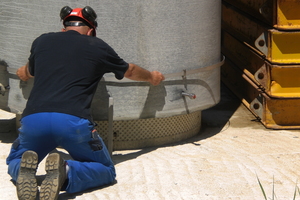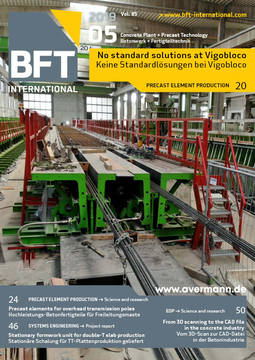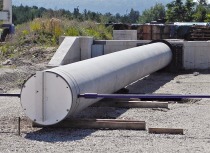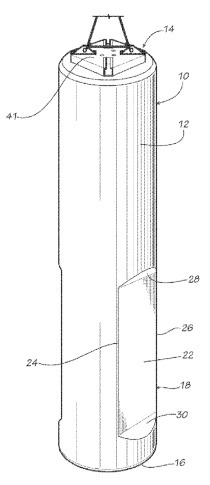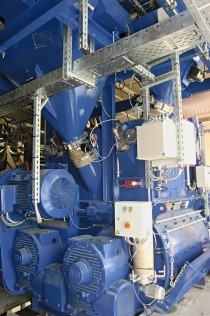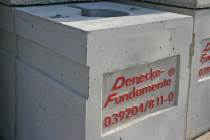High-performance precast concrete elements for overhead transmission poles
Prestressed, high-performance precast elements consisting of ultra-high performance spun concrete and high-strength reinforcement were developed as part of a joint research project of iBMB of the TU Braunschweig with the collaboration of the Europoles company; the elements were optimized for being used as extra-high voltage poles and constitute a cost-effective alternative to steel lattice poles.
1. Introduction
The energy transition in Germany imposes new requirements on the transmission of electricity. The electricity networks landscape shall be upgraded as fast as possible for the switch to renewable energies and designed in a future-proof way, thus building new power lines is unavoidable [1]. This enormous effort has to be ensured in due consideration of the major challenges of „people and the environment“ and „technological alternatives“ and, moreover, taking „cost-effectiveness“ into account as well.
At present, grid operators still rely on the current state of the art for the expansion of the 380-kV extra-high voltage network and are planning to construct overhead transmission poles in the space-consuming steel lattice construction method. Apart from the current state of the art, they often refer to low costs as an argument in favor of the steel lattice poles. Because of public concerns about their impact on human health, on nature and on the landscape, the permission of steel lattice poles becomes more and more the focus of discussion. The opposition to overhead power lines for new essential extra-high voltage transmission lines is primarily due to a negative attitude of the population and politics against „monster power lines“ using steel lattice poles.
In this connection, BMWi – the German Federal Ministry for Economic Affairs and Energy – sponsored the „Compact Extra-High Voltage Poles and Cross Arms“ („Kompakt-Höchstspannungsmaste und Traversen“ (in short: KoHöMaT)) joint research project for the development of an environmentally-friendly and resource-saving construction method for overhead transmission poles as part of extra-high voltage lines, leading to a considerable reduction in the power line width and the necessary area and space requirements due to a solid wall design and the compact arrangement of the conductors. Moreover, the innovative pole construction and optimized pole design result in a high degree of structural safety and low maintenance and life cycle costs.
2. Innovative pole construction
At present, concrete poles are discussed about in France, Denmark, the Netherlands and Italy as an alternative construction method to the current solutions of steel lattice poles, and they are already used to some extent because of a much higher degree of acceptance amongst the population, apart from other aspects.
In general, concrete poles are only used in the low-voltage range and for poles with a height of up to about 20 m [2] till the present day. However, the concrete pole design has already been proven as a basically possible application for high poles as well as for poles used in the extra-high voltage range by the following projects:
Pylon 310 (as a double-shaft dead-end tower) of the 380-kV power line between Innertkichen - Littau - Mettlener in Switzerland, with a height of roughly 60 m, manufactured in cast-in-situ construction in 1990 [3]
Pole 1 (as an industrial chimney) of the 380-kV power line from the „Reuter“ power plant to the „Reuter West“ power plant in Berlin, with a height of 66 m, manufactured in cast-in-situ construction in 1987 [4]
Suspension towers of the 500-kV power line for the Yangtze River overhead power line crossing at Nanjing in China, with a height of 257 m, manufactured in cast-in-situ construction in 1992 [5]
For the production of concrete pole structures, the centrifugal casting process provides significant advantages in comparison to conventional concrete manufacturing processes. For one thing, a higher concrete compressive strength and a higher concrete quality can be achieved (up to 30 % higher compressive strength, with the concrete mix design being exactly the same), which has a positive effect on the required cross-sectional area, hence on the weight and the material input. Furthermore, the reinforcing and prestressing steel is perfectly protected against corrosion because of the high compaction of the concrete as a result of the centrifugal process. The high surface quality is another positive effect of the centrifugal casting process. By using high-performance materials (e.g., UHPC, high-strength steel reinforcement), these properties can be further improved and the load-bearing capacity and durability of spun concrete poles can be further enhanced.
As part of the KoHöMaT joint research project, iBMB – Division of Concrete Construction of the TU Braunschweig – with the collaboration of Europoles GmbH & Co. KG (Europoles) developed prestressed, high-performance precast elements consisting of ultra-high performance spun concrete and high-strength reinforcement; the elements were optimized for the use as extra-high voltage poles and constitute a cost-effective alternative to steel lattice poles. At first, a UHPC mix design was developed and optimized and scientific tests were carried out regarding the properties and the interaction with normal- and high-strength reinforcement for the production of concrete in a centrifugal casting process. For the practical application of the „KoHöMaT“, moreover, full-scale tests were carried out to investigate the structural behavior of the concrete poles.
3. Development and optimization of a high-performance concrete
Spun concrete is a special kind of manufacturing and compacting of concrete. The production of spun concrete elements takes place in a rotationally symmetrical mold, into which the concrete is poured after the prefabricated reinforcement cage has been inserted. On a centrifugal bench the mold is then set in longitudinal rotation at a speed of about 600 revolutions per minute. As a result of the centrifugal forces of about 20-fold gravitational acceleration, the concrete is pressed against the interior wall of the mold and densely compacted. The centrifugal process is terminated as soon as the concrete features an appropriated green strength.
Basically, the development of a high-performance concrete for the production of concrete poles in a centrifugal process implicates specific requirements on the concrete, including a defined flowability and workability with a high green strength simultaneously, for instance. In addition, the material behavior, for example, in terms of the fatigue resistance (owing to wind load, etc.) or the resistance to thermal and electrical loads have to be taken into consideration for use in overhead transmission poles. And finally, special challenges arise in the production of the large-size trail poles. For one thing, this is due to the new concrete technology and the production parameters and time sequences which have to be adapted to the same and, for another thing, due to the adjustment of the procedure to the innovative pole design. The large diameters and the resulting concrete volume as well as the chosen conicity of the poles and the stabilization of the resulting longitudinal concrete transport during the centrifugal casting process, among others, are worth mentioning in this connection.
In order to meet these diverse requirements, Europoles developed an ultra-high performance concrete suitable for the centrifugal casting process, and in cooperation with the iBMB, Division of Concrete Construction of the TU Braunschweig, the concrete was optimized with regard to the production characteristics as well as the fresh and hardened concrete properties by continuous modifications of the concrete composition ([6], [7], [8]).
The developed ultra-high performance spun concrete (UHPSC) is based on a further development of the mix design for high-performance spun concretes up to C100/115, which have already been approved by building authorities for the production of poles, columns, and beams [9]. The basic materials for the UHPSC are standard cement, sand and basalt chips [10]. In addition, silica fume and quartz powder are used as admixtures which both increase the strength and have a positive effect on the workability of the fresh concrete. An increase in strength was moreover achieved by a reduction of the effective water/cement ratio. By combining two superplasticizers based on PCE, it was possible to meet the requirements related to the centrifugal process on the fresh concrete properties of the UHPSC, with one of them providing for an excellent initial plasticizing effect and the second one ensuring the consistency. It was possible to influence the duration of the workability by the ratio of the two additives, also as a function of the concrete temperature.
The short-term and long-term concrete behavior was evaluated for the optimized UHPSC mix design as well as the material characteristics relevant for design purposes were determined in comprehensive experimental investigations carried out at the iBMB, Division of Concrete Construction of the TU Braunschweig [8]. These investigations included:
Stress-strain relationship
Compressive strength (including strength development)
Modulus of elasticity
Tensile strength
Fatigue behavior (under fluctuating compressive stress)
Long-term behavior
Creep and shrinkage characteristics
Bond behavior (regarding reinforcement steel and prestressing steel)
A total of about 600 accompanying specimen tests were conducted. Figure 3 summarizes the results of the overall more than 300 compressive strength tests carried out on drilling cores taken from spun concrete (SB-BK, h/d = 110/55 mm), drilling cores taken form vibrated concrete (RB-BK, h/d = 110, 55 mm), standard test cylinders of vibrated concrete (RB-Z) and standard test cubes of vibrated concrete (RB-W). Further results regarding the mechanical characteristics of the UHPSC (stress-strain relationship, modulus of elasticity, tensile strength) are given in [8] and [11].
Besides the properties under short-term loading, the long-term material behavior of the UHPSC was investigated as well. In respect of the long-term behavior (even in case of very long service lives) a durability limit value of αlim ≈ 0.90 could be estimated in a first approximation on the basis of constant load tests on drilling cores (h/d = 110/55 mm) taken from spun concrete (Figure 4). This enables the derivation of a coefficient of αcc ≈ 0.9/1.09 ≈ 0.85, considering a conversion factor from the drilling core (h/d = 110/55 mm) taken from the spun concrete to the standard cylinder (h/d = 300/150 mm) of 1/1.09 (cf. [8]), which is also known from other investigations and normative rules [12], [13]. However, further investigations are required for a verified indication of the long-term behavior under constant loads.
It was moreover possible to demonstrate by means of selected fatigue tests on drilling cores taken from spun concrete subjected to fluctuating compressive stress that, in general, the UHPSC shows a fatigue behavior that is similar to normal- and high-strength vibrated concrete (cf. [11]) and that the existing normative models can be used as a good approximation for the design of the innovative poles. The general use of the UHPSC in other structures would require additional investigations with the boundary parameters of the specific building structure.
4. High-performance precast concrete poles
Apart from the ultra-high performance spun concrete, other high-performance materials (e.g., a high-strength reinforcement steel SAS670) were used for the development of innovative and space-optimized spun concrete poles. On the basis of a parameter study, the efficiency of the use of ultra-high performance concrete was investigated in combination with high-strength reinforcement steel (optimization of the wall thickness of the pole in order to reduce the material input) and the use of prestressing strands of a larger diameter (Ø 15.3 mm) in order to increase the cost-effectiveness. With relevance to practical application, alternative pole designs with external diameters of 1.5 m up to 3.0 m and lengths of about 26 m were developed on the basis of these investigations as well as realistic load scenarios of overhead transmission poles. Afterwards, Europoles produced several prototypes with different configurations (variations in dimensions, reinforcement, etc.) (Figure 5).
Experimental investigations regarding the load-bearing and deformation behavior subjected to relevant load combinations of bending and shear force and bending, shear, and torsion were carried out on a total of eight of these prototypes at a large-scale experimental set-up of Europoles (Figure 6, cf. [16]).
Furthermore, a practically feasible connection and joining system between spun concrete pole and foundation element (Figure 7), between two segments of the spun concrete pole, and between spun concrete pole and steel pole (for hybrid pole constructions) were developed and investigated [17].
Essential findings with respect to the production and the load-bearing behavior of these high-performance precast elements could be obtained on the basis of comprehensive theoretical and experimental investigations. The existing normative design models which have been adjusted in consideration of the material- and system-specific characteristics allow for a reliable production as well as safe design of the poles.
5. Summary
In the context of the necessary adjustment of the electricity grid infrastructure for the expansion of renewable energies, an innovative design of overhead transmission poles for extra-high voltage lines was developed as part of a „ Compact Extra-High Voltage Poles and Cross Arms (KoHöMaT)“ joint research project; this leads to a high degree of safety and durability at low maintenance and life cycle costs due to the use of high-performance materials and because of an optimized pole design.
By means of numerous theoretical and experimental investigations, it was possible to determine the properties of the ultra-high performance spun concrete subjected to short-term and long-term loading as well as to verify the suitability of the same for the production of spun concrete poles. Moreover, on the basis of tests carried out on large-size prototypes, the load-bearing capacity of spun concrete poles could be evaluated and basic principles for design and construction of spun concrete poles could be developed.
The development of a practically feasible connection system between foundation element and concrete pole and between the individual elements of the concrete pole, respectively, allows for a very quick and easy construction of the compact extra-high voltage poles. Innovative concrete and manufacturing technologies in combination with a modular design also demonstrate the efficiency of precast concrete construction in this field of application in an impressive way.
In order to extent the modular system (e.g., for an additional reduction in weight), hybrid poles consisting of different materials are also possible, i.e. they consist of a bottom concrete module and an upper solid steel module and can be used for construction in rough terrain.

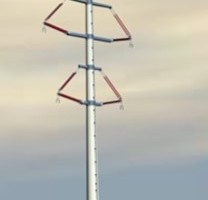
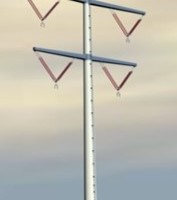
![Fig. 2: Application examples of the concrete pole construction in Littau (left [3]), in Berlin (center [4]) and in Nanjing (right [5])](https://www.bft-international.com/imgs/1/4/3/4/7/0/4/tok_63457c9d7d67ca54db146a21e4a22fcf/w300_h200_x600_y719_HA_1002_Fig.2a_Bild02li-f38b11692b2dc035.jpeg)
